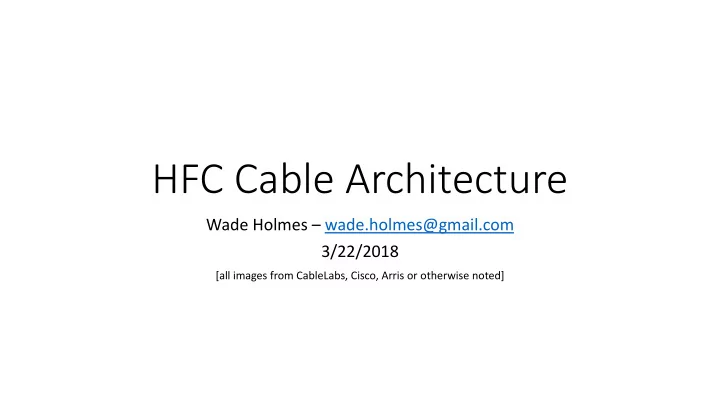

HFC Cable Architecture Wade Holmes – wade.holmes@gmail.com 3/22/2018 [all images from CableLabs, Cisco, Arris or otherwise noted]
Agenda • Overview of Cable as a technology: what the future holds • Architecture overview and terminology • The PHY layer • Hybrid Fiber Coaxial (HFC) system • Spectrum allocation, division, FDD • The MAC layer • DOCSIS, symbols, modulation • CPE • Products, speeds, performance in practice • Operations and Maintenance
Cable is generally not a popular topic..
Why Cable matters (even if we don’t like it) • HFC can deliver speeds in excess of 10gb/s on existing infrastructure • Franchise agreements in place, power, right of way, fiber-deep
Version and speed evolution
Future of Cable broadband is bright • DOCSIS 3.1 in early phases with 10-15 year useful life in current form • Full duplex DOCSIS emerging (FDX) which allows for 10gb symmetric • Fiber-deep architecture enables FTTH and node+0 technology • OFDM/OFDMA allows for highly efficient use of spectrum • LDCP replaces FEC in 3.1, adding efficiency • LTE can run over HFC, and it is headed that way with FDX • DOCSIS has been used over unlicensed wireless to add robustness
Terminology and Equipment • CMTS: Cable Modem Termination System • DOCSIS: Data over cable system interface standard • Cable Modem: Customer premise cable termination device • Node: a passive (but powered) optical to radio frequency transceiver • HFC: Hybrid fiber coaxial: a blend of optical and RF for distribution • Amplifier: a passive device to perform non-linear RF amplification • Spectrum: the RF band from 0-1.2GHz (typical) used in Cable • SC-QAM: single-channel QAM, normally 6.0 MHz (DS), 6.4 MHz (US) • Node+: Number of nodes in cascade • Upstream / Downstream: direction of RF amplification and data flow
Simplistic view of DOCSIS Network
Basics of Cable Network IP Core IP Edge
The HFC Reference Architecture
DOCSIS requires 4 management areas CMTS Spectrum Plant Customer
Roles in a Cable network • RF Engineer • Network Engineer • Headend Tech • Maintenance Tech • Field Tech • OSS Solution Engineer • BSS Integration • Customer Support (inside tech)
Cable Modem Termination System (i-CCAP) Cisco cBR8 Arris E6000
Remote PHY
Sample Output on CMTS Upstream Service Group Downstream Service Group Router# show cable mac-domain cable 7/1/0 upstream-service-group router#show cable mac-domain cable 7/0/0 rcc 5 simplified Cable MD 7/1/0 RCC ID : 5 US-SG-ID : 1 US-Chan : U0,1,2,3,4 Created Via : Wideband - Wi7/0/0:1 Primary-DS: 5/1/0:0 US-SG-ID: 1 CM attribute mask : 0x80000000 MDD US-List : U0,1,2,3 MDD Ambiguity : U0,1,2,3 Primary Receive Channel List: Primary-DS: 3/0/0:0 US-SG-ID: 1 Chan Idx RF Chan DCID Freq MDD US-List : U0,1,2,3,4 1 In7/0/0:0 1 453000000 MDD Ambiguity : U0,1,2,3,4 Primary-DS: 3/0/0:1 US-SG-ID: 1 Non-Primary Receive Channel List: MDD US-List : U0,1,2,3,4 Chan Idx RF Chan DCID Freq MDD Ambiguity : U0,1,2,3,4 2 In7/0/0:1 2 459000000 Primary-DS: 3/0/0:2 US-SG-ID: 1 3 In7/0/0:2 3 465000000 MDD US-List : U0,1,2,3,4 4 In7/0/0:3 4 471000000 MDD Ambiguity : U0,1,2,3,4 5 In7/0/0:4 5 477000000 Primary-DS: 3/0/0:3 US-SG-ID: 1 6 In7/0/0:5 6 483000000 MDD US-List : U0,1,2,3,4 … MDD Ambiguity : U0,1,2,3,4 24 In7/0/0:23 24 591000000 25 In7/0/0:158 159 663000000 OFDM Receive Channel List: Chan Idx RF Chan DCID PLC-Freq Profiles 25 In7/0/0:158 159 663000000 0 1 2
Return and Forward split at 42, 85 or 200MHz
Spectrum Allocation, Channels, Noise Upstream, single 6.4Mhz carrier Downstream, single 6.0Mhz carrier
Outside Plant
Capacity Relationship with Modulation (H) and Spectrum (V) (Gb/s) 256 -QAM 512-QAM 1024-QAM 2048-QAM 4096-QAM 8192-QAM Mhz EIA 5.33 b/Hz 5.63 b/Hz 6.39 b/Hz 6.99 b/Hz 7.60 b/Hz 8.20 b/Hz 384 64 2.04 2.16 2.45 2.68 2.91 3.14 336 56 1.79 1.89 2.14 2.34 2.55 2.75 288 48 1.53 1.62 1.84 2.01 2.18 2.36 License ($) 240 40 1.27 1.35 1.53 1.67 1.82 1.96 192 32 1.02 1.08 1.22 1.34 1.45 1.57 144 24 0.76 0.81 0.92 1.00 1.09 1.18 96 16 0.51 0.54 0.61 0.67 0.72 0.78 48 8 0.25 0.27 0.30 0.33 0.36 0.39 Capital ($) Maintenance and Process (dB) Effort and cost increase with higher modulation
Plant Peformance
Physical Layer https://en.wikipedia.org/wiki/Hybrid_fibre-coaxial#/media/File:HFC_Network_Diagram.svg
Two-Way Plant, commonly a “service group” Downstream (Forward) Upstream (Return) Graphic adapted from: Kevin Keaner, Aurora Networks
Another view of HFC Graphic: Kevin Keaner, Aurora Networks
CPE Options Bridge Gateway
DOCSIS Frame (w/ LDPC)
Other Notes • Plant power for nodes and amplifiers is 90v, field supplied • Leakage, flyover, sweeps • Unity Gain and RF maintenance • PNM • RDK, areas of industry leadership
Excellent Resources • Return Path Optimization from Aurora • CableLabs • Arris and Cisco, largest CMTS manufacturers • SCTE – Society of Cable and Telecommunications Engineers • Spectral Efficiency of DOCIS 3.1
Distributed Port Design Ports 1-8 Fusion Spliced Ports 9-16 1 OLT port per 64 HP Ports 17-24 Port Access Ports 25-36 OLT Ports 37-42 Port Ports 43-48 Distribution Ports 49-52 Ports 53-64
Recommend
More recommend